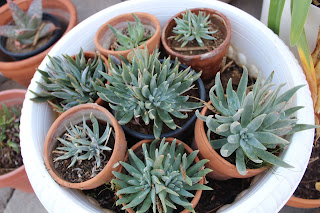The Wild Dudleyas of Rock River Hill!
In the mineral-rich hills surrounding our property, there could be quartz or lime outcroppings, sagebrush, bones of small dead animals, or even the remains of old mine shafts and prospecting claims.
A few years ago, on an exploratory hike through sage brush and bull pines, I discovered some small succulents growing prolifically among a quartz outcropping. As it was a dry season (it’s nearly always a dry season on Rock River Hill,) the plants looked half-dead, sad, and dried out.
There were a great deal of them, so I carefully dug one up, took it home, and planted it in a small container. Once it began receiving water regularly (about once a week or so,) the dry little leaves uncurled and the plant came back to life! The following spring, I was rewarded with pale coral blossoms surrounded by buzzing local pollinators.
We’ve since harvested several more and given them away to family and friends. I call it affectionately, “The Lazarus Plant,” after the man Lazarus in the Bible whom Jesus brought back to life. I gave one to my sister not too long ago, and hers has grown substantially, thriving on the regular watering she gives it.
This morning, my sister told me she had found out something interesting about these little succulents. It turns out, they may actually be special native plants known as Wild Dudleyas, also known as “Live Forevers.” They are only found natively on the West Coast of North America in California and some areas of Oregon.
Some species of Wild
Dudleyas are endangered, rare, and can live up to 100 years! In recent years,
there have been tragic cases of Wild Dudleya poaching in the High Desert
regions of California, where thieves come to areas ravaged by wildfires and
steal hundreds of the plants to sell on the black market. You can learn more about the Wild Dudleyas from the California Native Plant Society.
You can also learn more about the black market poaching of Wild Dudleyas Here.
Our species is most likely the Dudleya Cymosa, or “Canyon Live-Forevers.”
They are not one of
the endangered species, but I still probably shouldn’t have dug any up. Oh.
Thankfully, the large
crop on the hillside where I originally harvested a few is still going strong. It grows during the wet season, dries out in the dry seasons, and returns to
life again whenever it rains. The crop is in an area that would be very difficult to develop, so it's likely these little plants will continue to thrive for hundreds of years to come.
You just never know
what you’ll find near Rock River Hill.






So interesting!
ReplyDeleteNext time you visit, I'll have to send you home with one. :)
Delete